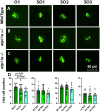The P4-phospholipid flippase Atp11a is required for maintenance of eye and ear structure in zebrafish
- PMID: 40223426
- PMCID: PMC12148042
- DOI: 10.1242/jcs.263657
The P4-phospholipid flippase Atp11a is required for maintenance of eye and ear structure in zebrafish
Abstract
The atp11a gene encodes a phospholipid flippase protein required to flip phosphatidylserine (PS) and phosphatidylethanolamine (PE) from the outer leaflet of the cytoplasmic membrane to the inner leaflet. Mutations in ATP11A have been described in individuals with sensorineural hearing loss and neurological deterioration; however, little is known regarding the mechanism by which loss of atp11a results in such phenotypes. To this end, we created loss-of-function atp11a mutant zebrafish to characterize potential disease states. We demonstrate that mutant atp11a zebrafish display a reduced number of stereocilia in the larval ear and a reduced number of hair cells in some sensory neuromasts, indicating that these fish represent an ideal model for studying atp11a-attributable hearing loss. In addition, atp11a mutant zebrafish raised in a standard light cycle have reduced photoreceptor outer segments, the severity of which is lessened when mutant larvae are raised in the dark. Photoreceptors that do remain in homozygous atp11a mutants undergo mitochondrial fission and produce an increased number of mitochondria, suggesting that defects in energy homeostasis may contribute to or result from outer segment degradation.
Keywords: atp11a; Hair cell; Photoreceptor; Retinal pigment epithelium; Stereocilia; Zebrafish.
© 2025. Published by The Company of Biologists.
Conflict of interest statement
Competing interests The authors declare no competing or financial interests.
Figures







References
-
- Arashiki, N., Takakuwa, Y., Mohandas, N., Hale, J., Yoshida, K., Ogura, H., Utsugisawa, T., Ohga, S., Miyano, S., Ogawa, S.et al. (2016). ATP11C is a major flippase in human erythrocytes and its defect causes congenital hemolytic anemia. Haematologica 101, 559-565. 10.3324/haematol.2016.142273 - DOI - PMC - PubMed
MeSH terms
Substances
Grants and funding
LinkOut - more resources
Full Text Sources
Molecular Biology Databases

